In this article, we seek to examine child custody agreements, their important parts, and the tips that can help guardians during this delicate process.
The simple question is: What is in the child’s best interest? These papers are vital since they determine where a child will live, how another parent will communicate with him or her, and many other issues that affect his or her well-being.
Such ambiguities include but are not limited to legal perspectives as well as practical considerations which are essential for a smooth and constructive transition for all involved parties.
This guide is an extensive explanation of child custody agreements discussing crucial components, tips on how to prepare yourself, and invaluable pieces of information that parents need to have so that they can be able to use them throughout this difficult journey.
What are Child Custody Agreements?
Legal guardianship contracts are simply legal documents that show how children below the age of 18 will be cared for by their parents when they separate or divorce.
They spell out who will have physical custody (where the child lives) and legal custody (the right to make major decisions regarding the child’s life, including education, health care, and religion).
Child custody agreements consist of a number of things such as:
- Physical Custody: Points out where a child should live and how often such a child should visit the parent without custody or other relatives.
- Legal Custody: Decides which parent or both parents can take decisive actions about issues affecting their kid(s)’ welfare, academic life, and wellbeing in terms of healthiness and religious education.
- Visitation Schedule: This outlines the timing when noncustodial parent meets with minors mostly regular visits such as weekends, and public holidays like Christmas occasions.
- Communication Guidelines: It details how communication between parents should take place including means of contact and regularity.
- Child Support: Takes care of all financial needs for the baby whereby how much money every month is paid by one spouse to another to pay the child’s expenses.
- Dispute Resolution: This part deals with settlement mechanisms for any conflicts between two divorced individuals concerning such subjects as custody or visitation plans – e.g., mediation or arbitration.
With or without lawyers and mediators available, couples’ negotiation gives birth to them; otherwise, courts might decide so during divorce proceedings. Consequently, after subsequent approval from court orders, they become enforceable as well as legally binding on both parties. However, they can be modified later if circumstances change or if both parties agree to other conditions.
Read More: Understanding What Is Co-Parenting: 10 Game-Changing Tips For Being A Great Co-Parent!
How To Prepare A Custody Agreement?
Preparing a custody agreement, therefore, entails thoughts on the child’s interests and needs, along with the rights and obligations of both parents.
Here are ten tips to help you through this process:
1. Know Your State’s Laws:
Therefore, it is important to deeply delve into understanding your state or jurisdiction’s child custody laws because they vary greatly. Becoming aware of the legal framework will assist you in navigating the process better and ensuring that your custody agreement complies with all relevant regulations and requirements.
2. Give Priority to Child’s Best Interest:
Thus, during the entire custody agreement process, make sure that you have considered only what is good for the child as well as his/her welfare. In crafting it looks at their emotional, physical, and developmental needs; and aims at establishing an environment where there can be growth and happiness.
Read More: Top 5 Shocking Psychological Effects of Divorce on Children!
3. Open Communication:
Consequently, promote openness in communication between each other throughout the process respecting one another as parents. Approach any disputes constructively so as to achieve agreements in favor of children while listening to comments from others.
4. Consider Legal Action:
It is vital to seek the advice of a good lawyer who deals with issues of child custody in the family. They help you so much since they are well conversant with every bit of complexity that comes along with this document when it is being prepared and when it is being negotiated.
A skilled attorney will be an invaluable resource, aiding clients in understanding their legal options, foreseeing potential roadblocks, and representing them effectively.
Therefore, having a legal expert beside you will give you confidence since you will navigate the intricate web of legal systems knowing that there shall be justice at the end of it all.
5. Come up with Parenting Restrictions:
The need to make a detailed parenting plan cannot be overemphasized as it ensures an uneventful custody agreement. This kind of arrangement should cover each feature relating to custodial and visitation arrangements without leaving any uncertainties about it whatsoever.
Include weekly schedules, weekend activities, holiday plans, vacation timetables and provisions on special occasions.
Moreover, such matters as transport and communication between parents involved must not be forgotten to bring clarity and efficacy in implementation. A comprehensive parenting plan serves as an indispensable guide for both parents, ensuring uniformity and permanence throughout the child’s life notwithstanding any transitions that may occur from time to time.
Read More: What Is Parallel Parenting: 10 Key Tips For Divorced Parents
6. Take into Account the Child’s Daily Schedule:
What needs to be carefully considered while framing the custody agreement are; the daily activities of children; academic involvements in schools; extracurricular subjects taken by these kids; and other peculiarities or wishes they might have expressed.
To maintain continuity and stability during transfers one has to synchronize them with the child’s routine.
By including what a child does or prefers in this accord parents demonstrate their commitment towards safeguarding their welfare thus making a conducive environment that helps develop children better.
7. Flexibility and Realism are Important:
Family dynamics are dynamic, therefore when preparing a custody agreement, it is important to consider the changing nature of the family. Always understand that circumstances change with time and this may necessitate changes in its terms.
Define flexibility in the agreement as regards changes in schedules, relocation of parents or unforeseen events. While negotiating, one should be realistic and cooperative enough to come up with alternative solutions that can benefit both them and the child.
Transitions are facilitated by being flexible and realistic thereby making co-parenting “work” for everyone involved at least as far as children’s interest is concerned.
8. Resolving Differences:
For constructive resolution of disputes, custody agreements should have conflict resolution mechanisms. Detail how custody or visitation conflicts can be resolved through clauses.
Dialogue between parties can be fostered using mediation or other alternative dispute resolutions where common ground leading to consent orders can be reached to avoid trials in court.
Minimize disputes among children by checking for problems before they occur so that a suitable mechanism for dealing with them may exist.
9. Review & Revise as Necessary:
In order to stay responsive to changing circumstances, these documents require regular review and modification must be done on them frequently; thus view custody agreements as dynamic documents. Keep assessing the document continuously against the child’s future needs as well as those of both parents
Change it in good time if anything changes or some other provisions seem not feasible or sustainable over a long period at all costs
This ensures that there is continuity in communication among parents hence enforcing an effective custody agreement for both parties involved.
10. Obtain Court Approval:
The process of formalizing this arrangement begins by filing a copy of this parenting plan with the court so that it receives an endorsement from it regarding what has been agreed upon between the two parties.
It would also offer legal validation of your parenting plan while preventing any potential disputes/challenges later on because court approval brings with it legal bindingness.
The involvement of a court gives the agreement a sense of legitimacy and prevents any future disputes about it.
Therefore, by obtaining judicial recognition, parents can put in place an enforceable custody arrangement that is stable and secure for their children.
By adhering to these suggestions and having empathy, cooperation in mind, and keeping focus on what is good for your child you can achieve a shared parenting arrangement that supports your family and provides a stable, nurturing environment for the growing child.
Read More: Solo Parenting vs Single Parenting: Which Is The Best Option For Your Family?
A Word From Mind Family
In the journey of crafting a custody agreement, Mind Family emphasizes the paramount importance of prioritizing the child’s well-being above all else. Our heartfelt advice resonates with the essence of understanding, communication, and flexibility.
Remember, amidst the legal intricacies, the child’s happiness and stability stand paramount. Engage in open dialogue, seek guidance when needed, and remain adaptable to evolving circumstances.
Let empathy and cooperation guide your path as you navigate this intricate terrain. Together, let’s foster an environment where the child feels loved, supported, and nurtured, laying the foundation for a harmonious family dynamic.
Frequently Asked Questions (FAQs)
1. What are child custody agreements?
Child custody agreements are legal documents outlining custody arrangements for minor children, dictating physical and legal custody, visitation schedules, communication guidelines, and child support.
2. How to prepare a custody agreement?
To prepare a custody agreement, understand state laws, prioritize the child’s interests, communicate openly, seek legal advice, create a detailed parenting plan, consider the child’s routine, be flexible, address conflict resolution, review and revise, and obtain court approval.
3. What is the best arrangement for child custody?
The best custody arrangement prioritizes the child’s well-being, fostering stability, consistency, and support, while considering the child’s needs, routines, and developmental requirements. It should encourage open communication, flexibility, and cooperation between parents, aiming for a harmonious and nurturing environment.














Leave a Reply